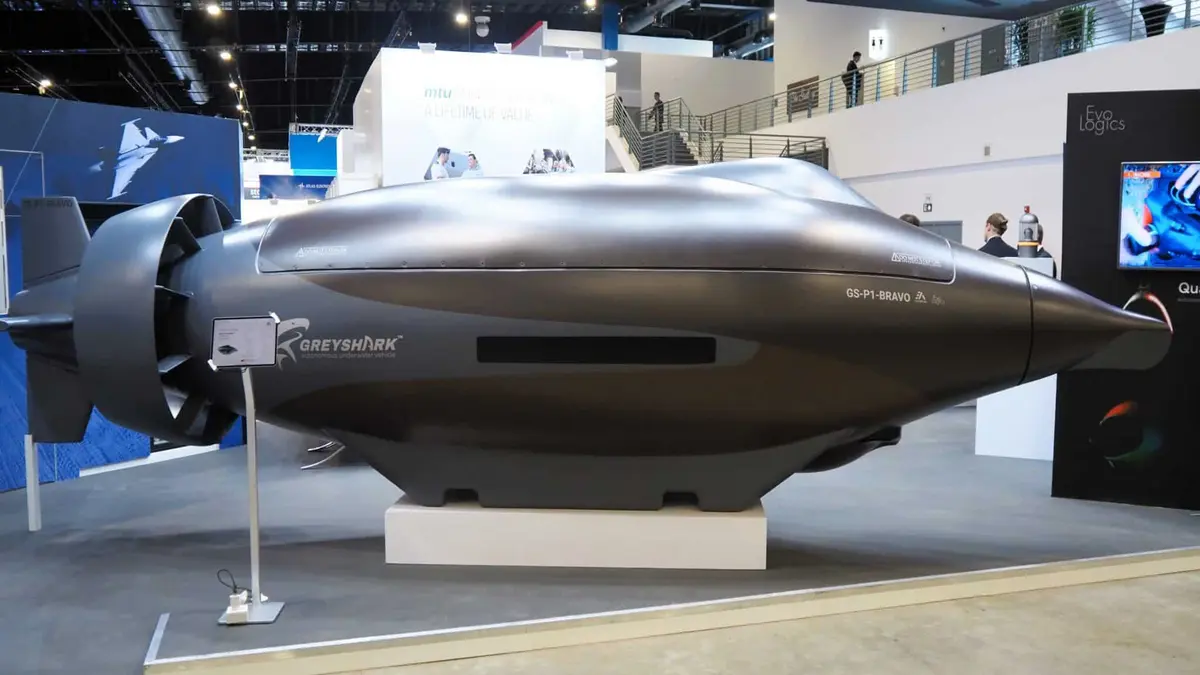“(Düsseldorf/Bremen — August 11, 2025) – In a move to refocus on protecting Europe’s coastal waters and maritime infrastructure, EUROATLAS and Rheinmetall have entered into a strategic partnership to integrate the GREYSHARK autonomous underwater vehicle (AUV) into Rheinmetall’s coastal defense architecture. The collaboration will also see the co-development of new GREYSHARK variants tailored to maritime security needs.
The agreement envisions GREYSHARK operating not as a stand-alone platform, but as part of a connected coastal surveillance and defense network. By connecting the AUV directly to shore-based radars, acoustic arrays and Rheinmetall’s multi-domain command-and-control (C2) systems, operators will be able to plan missions, monitor the situation and feed real-time data into a shared maritime picture.
- EUROATLAS GreyShark UUV model at IMDEX Asia 2025. (Alex Luck)
Building operational compatibility
At the heart of the partnership is the goal of turning proven AUV technology into an operationally relevant, repeatable capability. GREYSHARK’s modular design allows it to be configured for multiple mission profiles, from routine harbor patrols to complex mine countermeasure (MCM) operations. Rheinmetall’s role will be to ensure seamless integration with existing and future coastal systems so that AUV-collected data can be rapidly processed, analyzed and acted upon.
The first phase of work will focus on three priority mission sets:
- Mine Countermeasure (MCM): Quickly detect and classify threats and crude ships using high-resolution sonar with reduced risk to.
- Maritime Infrastructure Security: Regularly inspecting submarine cables, pipelines and port approaches.
- Littoral Intelligence, Surveillance and Reconnaissance (ISR): Collecting intelligence without revealing position by operating quietly in shallow or congested waters.

- Artist rendering of Greyshark scanning for tethered mines. (EUROATLAS)
Responding to emerging threats
This partnership comes at a time when European maritime security planners are reassessing vulnerabilities following a series of incidents involving maritime infrastructure. The Baltic, North Sea and Mediterranean all present unique challenges: shallow depths, heavy commercial traffic and complex acoustic environments. In such conditions, patrols and divers operated by low-signature AUVs provide a safer and more continuous provides an alternative.
By embedding Greyshark into a layered defense system, EUROATLAS and Rheinmetall aim to move from small-scale trials to a scalable capability that can be deployed in multiple regions and tailored to different national needs.
Modularity and integration benefits
GREESHARK’s modular architecture means that payloads – such as side-scan sonar, environmental sensors or optical imaging systems – can be swapped out based on mission requirements. Integration with Rheinmetall’s Coastal C2 environment will focus on:
- Mission planning and dynamic operation: Allowing operators to set routes, re-task on the fly and monitor vehicle health.
- Data fusion: Feeding sonar and sensor outputs into a common operational picture for rapid decision-making.
- Autonomy and safety features: Ensuring collision avoidance, secure communications and reliability in busy coastal areas.
Strategic Ambitions and Potential Threats
The collaboration is designed to produce not just a baseline AUV but a family of systems with varying range, endurance and payload options. This could support a common principle for European port clearance, route survey and infrastructure patrol missions.
Potential benefits include:
- Reduced operational risk to crews.
- Fast, quiet mine countermeasures operations.
- Continuous monitoring of critical seabed assets.
- The foundation for future multi-AUV “swarm” tactics.
The challenges remain in ensuring reliable autonomy in unmanned shallow areas, protecting communications in contested environments and establishing clear rules of engagement for unmanned systems facing suspicious activity.
- Greyshark Sensor Suite. (Euroatlas)
Looking ahead We are
The coming months are expected to bring announcements on where the first integrated Greyshark systems will be trialed, what payload enhancements are planned, and how the partners intend to standardize the interface for interoperability with allied fleets. A successful operational trial could shorten mine clearance timelines, reduce false-alarm rates, and set a precedent for how AUVs can be fully embedded in coastal defense strategies.
Final Thoughts
The Euroatlas-Rhinemetall partnership marks a shift from experimental deployments to a more integrated, coordinated approach to unmanned coastal defense. If the integration delivers reliable, measurable results, Greyshark could become a central element in efforts to protect Europe’s coastal waters and the maritime infrastructure that supports its economy and security.”
Read More: Chinese Vessels Collide During Pursuit of Philippine Boat in South China Sea, Raising Tensions
FAQs
GREYSHARK is an advanced autonomous underwater vehicle (AUV) developed by EUROATLAS. It is designed to carry out missions such as mine detection, port patrols and protecting submarine cables or pipelines. Working with Rheinmetall, it will now be integrated into coastal defense systems, giving Europe stronger protection against growing maritime threats.
The partnership will connect GREYSHARK directly to coastal command systems, radars and sensors. This means defense teams can plan missions, monitor activity in real time and respond quickly to threats. With increasing global tensions and incidents at sea, such as the disputes in the South China Sea, having reliable underwater defense technology is becoming a top priority.
Unlike human divers or patrol boats, GREYSHARK operates quietly and safely in shallow or busy waters. It reduces risk to the crew, can quickly detect mines, and provides 24-hour surveillance of critical areas such as ports or the seabed. This makes it a smart and safe option for modern coastal defense.








Leave a Reply